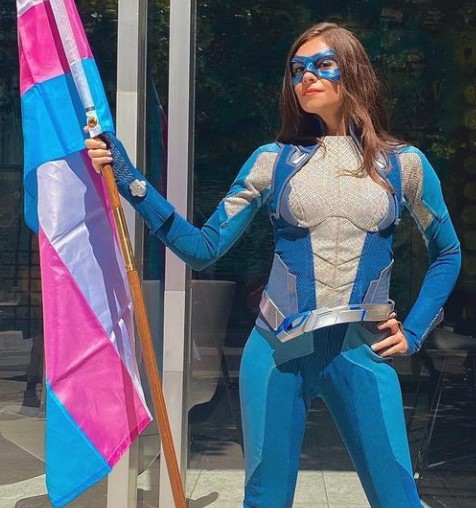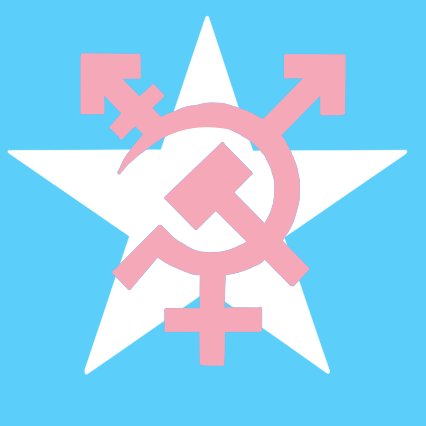A chairdre! This is a continuation of our discussion from the previous post: https://lemmygrad.ml/post/395378
Firstly, the link to the essay collection in question: https://transreads.org/wp-content/uploads/2021/07/2021-07-15_60f0b3d5edcb7_jules-joanne-gleeson-transgender-marxism-1.pdf
Today, I’ll be reading the first essay in the collection, Social Reproduction and Social Cognition: Theorizing (Trans)gender Identity Development in Community Context - Noah Zazanis
Noah Zazanis is a Marxist feminist, epidemiological researcher, and unrepentant transsexual. He lives in Queens and writes and organizes when he can.
I’ll pull some quotes and make some notes.
I hope that this will spark a discussion, or at the very least someone will have a chance to learn a little something <3
Edit 1: The discussion continues here with the second essay by Michelle O’Brien here - https://lemmygrad.ml/post/397671
In reference to Catharine MacKinnon’s Feminism, Method, Marxism and the State
“‘Gender socialization’, she writes, ‘is the process through which women come to identify themselves as sexual beings, as beings which exist for men. It is that process through which women internalise (make their own) a male image of their sexuality as their identity as women’. Womanhood, to MacKinnon, is defined through coercion into heterosexuality. In this view, the defining characteristic of women’s shared subjectivity is powerlessness at the hands of men, as reinforced through sexual objectification.”
This viewpoint (as Zazanis goes on to say) does reflect how many women experience their womanhood. However, seeing this as the sum totality of womanhood, which can be common in radical feminists, lends itself readily to trans-antagonistic viewpoints. This is where so many of the modern “gender critical” movement takes its fuel. Even trans inclusive radical feminists can easily provide ammunition from which gender critical feminists are able to assault the position of transgender inclusion in the category of womanhood.
CW: The quote from Meghan Murphy misgenders Shon Faye here, because Meghan Murphy is a huge tool.
Referring to Shon Faye, a UK-based trans woman and activist, Canadian feminist Meghan Murphy writes:
Faye has only been living as a self-defined transwoman for two years, meaning that for 27 years, he [sic] was socialised as a male, and offered all the power and privilege men are under patriarchy. He [sic] has no idea what it feels like to fear pregnancy, to be talked down to or over, to be discriminated against in the workplace, to live in fear of rape or abuse in private and in public, from the time he [sic] was a child.
This is, of course, both empirically and experientially false. For instance, trans women experience sexual violence and intimate partner violence at rates higher than those typical for cis women.
Meghan Murphy, as a side-note, is such a deeply infuriating woman.
Anyway, as we can see here, the idea that womanhood exists as a form of socialization of men’s oppression of women enacted upon them and thus exclusionary to trans material reality, can be easily discounted. It also can be easily discounted in regards to cis people: there are men who live in fear of rape and abuse from the time they are children, and there are women entirely free from the fear of pregnancy. It’s such a reductive outlook, but it is often defended viciously despite how quickly counter-examples can be shown that invalidate it as a framework for understanding gender.
Zazanis’s follow-up is also quite solid: if socialization of gender is something enacted exclusively by men upon women, then where does agency enter into the equation? If gender is something inherently and incontrovertibly enforced on women, then why are there women who fail to conform? Even putting aside transness, there are and always have been, cis women who refuse to perform the gender role of woman, who do not conform to the social proscriptions. By failing to account for individual agency in gender, a view of womanhood that is doomed to always be subservient to men is all that is left.
From Marx’s Eighteenth Brumaire
“Men make their own history, but they do not make it as they please; they do not make it under self-selected circumstances, but under the circumstances existing already, given and transmitted from the past. The tradition of all dead generations weighs like a nightmare on the brains of the living.”
Following Marx, it can be understood that roles in society are a product of social reproduction, depending on reproductive labour to enforce and continue them. In this way, there is agency for those who participate in society. They may reproduce the roles and ideas of the past, or they may choose to step outside of those roles and work to undermine these concepts and strive for new understanding and new relations.
“In an article for Viewpoint Magazine, Fulvia Serra emphasises the importance of nurturance and emotional intimacy as modes of reproduction necessary for creating and sustaining revolutionary movements.”
Fulvia’s stance is that intimacy has been enclosed into households–we see this as true through our examinations of Fordian nuclear families, where communal identity is dissolved in favour of individualism. Liberal feminism, argues Fulvia, is primarily concerned with placing women into the roles of men in the workforce. We also see this with the classic “girlboss” narrative that liberal feminists push. That somehow there is a victory for women by having women participate in the same structures of exploitation as men.
However reproductive labour is still a necessary part of the reproduction of the workforce, and so capitalism steps into the gap and while elevating cis white women into the roles previously reserved for men and celebrating it as a progressive victory, marginalized women (usually migrant workers from exploited nations in the global south) are indentured into reproductive labour.
“Instead, citing Silvia Federici, Serra pushes for changes in the fundamental mode of reproduction through the collectivisation of care labour, so as to undo the ‘hierarchy and domination’ inherent in the division of reproductive labour across gendered lines.”
“trans people produce and reproduce our own identities, through our relationships and social spheres. While transition is often framed as a process of shifting encounters with cisgender expectations, [Gleeson] clarifies that it is equally a process of active community cultivation, and sustenance of trans identity. Through ‘support, mentoring, and reciprocal recognition’, as well as the curation and dissemination of ‘shared knowledge’ and ‘practical wisdom’, trans people ourselves facilitate the development of transgender identities in community with one another”
This is a framework of revolutionary modes of social reproduction. A communal effort for care that does away with the capitalist-enforced gender hierarchies that insist on reproductive care as an act of unpaid labour contained within individual nuclear families. We’ve all heard the phrase “it takes a village to raise a child” but the trans community has been keeping that adage alive in practical terms, crafting communities that foster social reproduction as a joint effort whereby care is a give and take and a shared burden.
This can be applied widely, where many of the symptoms of capitalist indoctrination are reproduced through closed-system families. This is one of the most powerful tools individualism has for its reproduction, for instance.
What follows is an explanation of Social Cognitive Theory. In SCT, gender identity is a lifelong formation, largely reproduced through “triadic reciprocal causation.” Basically, gender identity is formed (and reformed) through personal, behavioural and environmental factors.
In each person, the level to which these factors influence gender identity varies (the text gives the example that societies with very rigid gender roles will result in environmental factors playing a larger role in gender identity formation than personal factors. This tracks, as we see that in societies with less exposure to gender-nonconforming or societies that punish gender non-conforming harsher there is a more rigid and cisgender formation of identity).
Environmental influence is broken down into three main factors: modelling, enactive experience, and direct tuition.
Modelling: family, peers, media all show people models of what gender roles/identities should look like. For most people, your earliest models will be your direct family
Enactive experience: once you begin to perform your gender, the reactions you receive will help to shape your gender identity. For instance, a cis boy may wear makeup and be punished, teased, etc, and cease to wear makeup as he ages as a result. This is a form of enactive experience, where the constraints and performance of the role of man are shown to him through the negative responses he received to deviation from expected behaviours. This isn’t a trans thing: cisgender identity is largely a result of punishment for gender identity deviation. Boys are taught what is and isn’t manly. Girls are taught what is and isn’t feminine.
Cisgender norms are not a given: they are reinforced and reproduced. This isn’t necessarily always a conscious effort. Seeing your mom and thinking: “this is what it means to be a woman” is not the same as your mom punishing you for playing sports because that’s “boy behaviour.” Cisgender identities are cultivated and reproduced often without intent, whereby cis people tend to believe it is the “natural” or “inherent” set of gender roles.
In the same way, trans people (often before they are even aware of being trans) seek out and cultivate trans communities, where they are able to reproduce trans gender identities. These communities allow trans people to see models for gender roles that had previously been missing, to have enactive experiences that are affirming of deviation from cisgender norms rather than punitive.
This is why trans communities are an essential part of transition for many trans people. By being able to overcome the internalized normativity of cisgender identity roles, a belief that transition can be meaningful and actually affect their material reality is often integral to taking the step to realization of trans identity and a desire to pursue transition.

